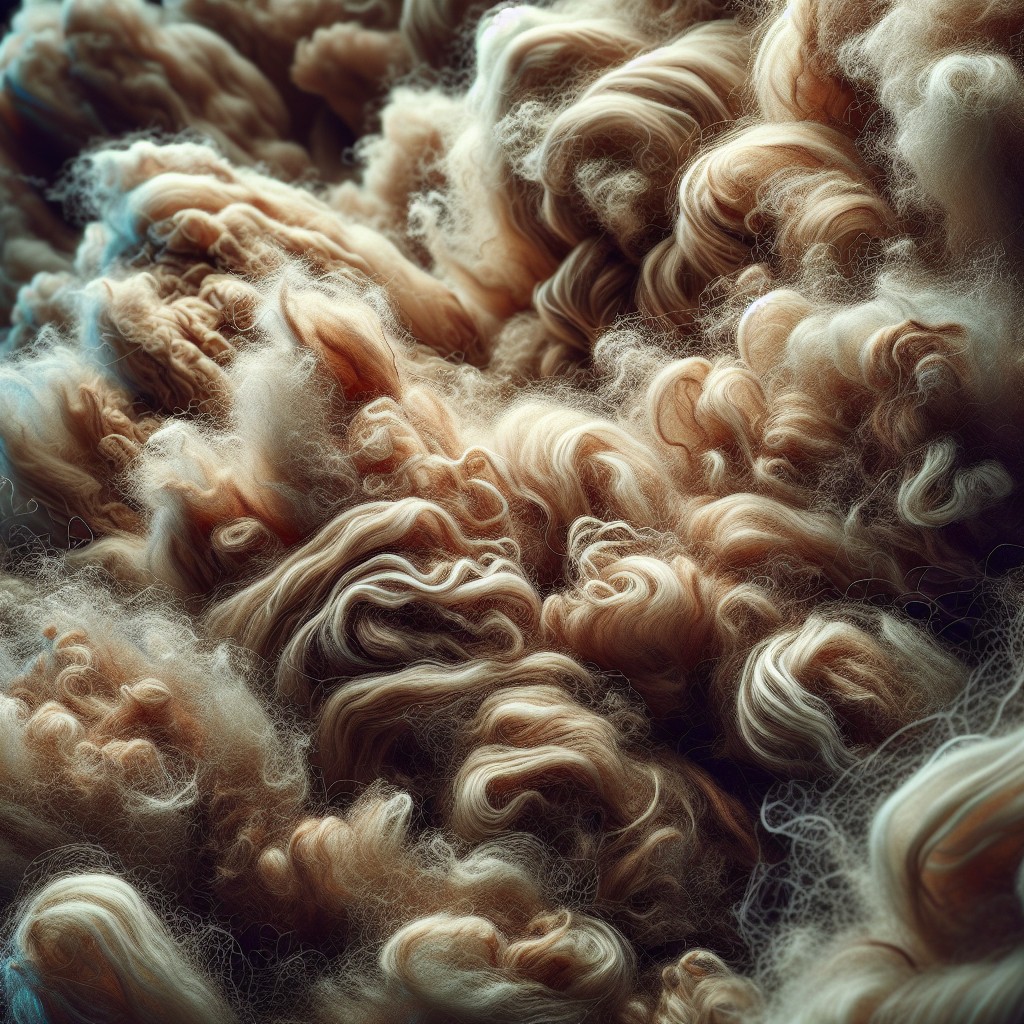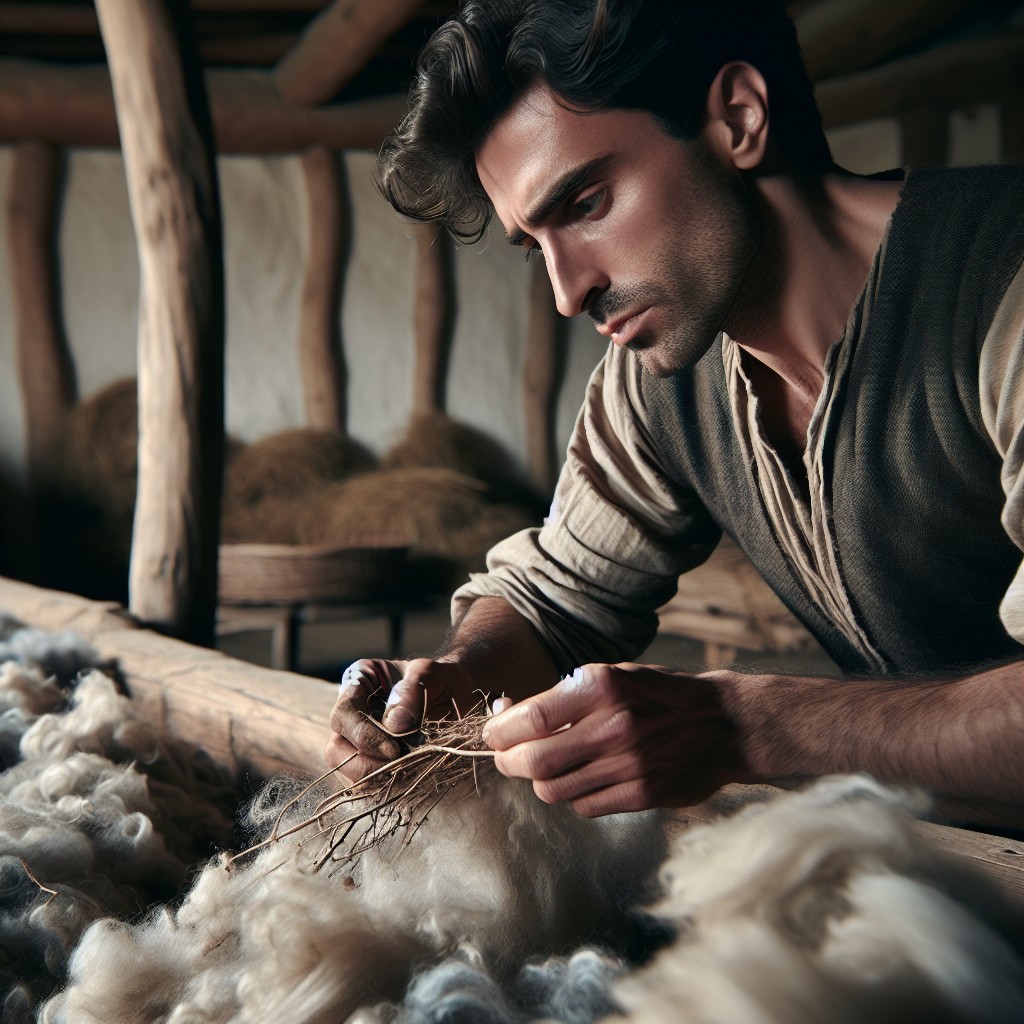Discover the art of spinning alpaca wool because it’s an enjoyable way to create unique, luxurious yarns for all your knitting and crocheting projects.
Key takeaways:
- Alpaca is warm, soft, and hypoallergenic.
- Huacaya and Suri alpaca produce different types of fleece.
- Properly clean alpaca wool before spinning.
- Prepare alpaca by sorting, washing, and carding or combing.
- Use spinning techniques that suit alpaca’s smoothness and lack of elasticity.
Characteristics of Alpaca Fiber

Alpaca fiber is renowned for its warmth, softness, and hypoallergenic properties, making it a luxury choice for spinners and crafters. The fiber lacks lanolin, eliminating the need for extensive cleaning and making it suitable for sensitive skin. Additionally, alpaca comes in an impressive range of natural colors, from white, fawn, and brown to gray and black, offering a rich palette without dyeing.
The two breeds, Huacaya and Suri, produce distinct fleece types. Huacaya alpaca provides a crimpy, elastic wool ideal for creating loft and resilience in yarn, while Suri yields long, silky fibers well-suited for drape and luster. When spun, both types exhibit excellent thermal qualities due to the fibers’ semi-hollow structure. Moreover, alpaca’s durability tends to improve with proper blending, often mixed with sheep’s wool or other fibers to enhance elasticity and memory in the finished yarn.
Types of Alpaca

Huacaya and Suri are the two breeds that provide the wool commonly used in spinning. The Huacaya alpaca produces a soft, crimpy fleece that resembles sheep wool in texture, offering elasticity and loft to the yarn. This type is more widely available and preferred for its ease of spinning.
On the other hand, Suri alpaca fleece is known for its silky, lustrous locks that hang down and can be more challenging to spin due to the absence of crimp. The fibers from a Suri alpaca result in a yarn with a natural drape and sheen, ideal for projects that require a silky texture.
Each type yields a different tactile experience and aesthetic in the final spun yarn, from the springy warmth of Huacaya to the elegant drape of Suri. Your choice between Huacaya and Suri will dictate not only the spinning experience but also the end use of your handspun alpaca wool.
Cleaning Alpaca Wool

Before diving into the spinning process, it’s essential to properly clean the alpaca wool, as it typically contains a fair amount of dirt, dust, and natural oils.
1. Skirt the fleece to remove any large pieces of debris, weak fibers, and excessively dirty or matted areas.
2. Fill a basin with lukewarm water, and use a mild, pH-neutral detergent or wool wash. Hot water or agitation can cause felting, so keep the water temperature consistent.
3. Gently submerge the wool, letting it soak for 10 to 15 minutes to loosen the dirt. Avoid agitating or rubbing the fibers to prevent felting.
4. Carefully lift the wool from the water, and drain the basin. Refill it with clean, lukewarm water for rinsing.
5. Repeat the soaking process without detergent to rinse out dirt and soap. This may need to be done several times until the water is clear.
6. After the final rinse, gently press excess water out of the fiber. Do not twist or wring, as this can distort the fibers.
7. Lay the clean wool out on a towel or mesh rack to slowly air dry, making sure it’s not exposed to direct sunlight or heat.
Preparing Alpaca For Handspinning

Before you begin spinning, ensure the alpaca fiber is adequately prepared to make the process smoother and the end result more consistent. Start by sorting the fleece, removing guard hairs and debris as these can cause scratchiness in the final yarn. Next, wash the fiber gently in a tub of warm water with a mild detergent, swishing without agitation to avoid felting, and rinse thoroughly until the water runs clear.
After washing, carding is the next step. You can use hand carders or a drum carder to align the fibers, which makes drafting easier during spinning. Create rolags or batts – these are manageable chunks of fiber that will feed easily onto your spindle or wheel.
If you have a preference for combed yarn, which is smoother and produces a denser, more lustrous thread, use a comb instead of carders for preparation. This will result in long, aligned fibers known as top or sliver, ideal for worsted spinning methods.
Consider blending your alpaca with another fiber such as wool or silk if you desire a blend of properties in your yarn, such as added elasticity or shine. Thoroughly mix the fibers before spinning to ensure an even blend throughout the yarn.
With the prep work done, you are now set up for a successful handspinning session, ready to turn your quality prepared alpaca fibers into beautiful, handmade yarn.
Spinning Techniques for Alpaca Wool
Alpaca fiber’s smoothness requires gentle tension during spinning to avoid creating overly-slippy yarn. The worsted technique, involving short, forward hand movements, emphasizes this fiber’s drape and sheen. Conversely, the woolen method, with long, backward hand movements, introduces air, enhancing loft and insulation. Keep a consistent rhythm to prevent uneven yarn thickness.
Plying multiple strands can increase strength and uniformity. Be mindful that alpaca lacks elasticity; when plying, avoid over-twisting that leads to a stiff yarn. Experimenting with a blend of alpaca and wool can impart more springiness to the final product.
For those using a spinning wheel, a higher ratio creates finer yarn, while a lower ratio suits bulkier, more textured yarn. The proper spinner’s oil application ensures a smoothly operating wheel, critical for working with alpaca’s sleek fibers.
For spindle spinners, a lighter spindle aids in creating fine alpaca yarn, whereas a heavier one is suitable for chunkier outputs. Careful drafting, the fiber-pulling process before twisting, is crucial for maintaining an even yarn weight throughout the spinning process.
Finishing Alpaca Yarn
Once your alpaca yarn has been spun, the finishing process is crucial for setting the twist and improving the yarn’s handle. Begin by winding the yarn into a skein using a niddy noddy or the back of a chair to keep it from tangling. Tie the skein in several places with figure-eight ties to secure it during washing.
Submerge the skein in lukewarm water with a gentle wool wash or mild soap to remove any spinning oils and dirt. Avoid agitation, as alpaca fiber can felt easily. After soaking for about 15-30 minutes, rinse the yarn in water of the same temperature to prevent shocking the fibers.
Gently squeeze out excess water without wringing, and roll the skein in a towel to remove moisture. To set the yarn’s twist, you may snap the skein by holding each end and briskly snapping it outwards. This will help align the fibers.
Hang the skein to dry away from direct sunlight and heat sources. While wet, the skein can be weighted slightly to encourage stretching and to help the yarn dry straight. Once dry, your alpaca yarn is ready to be knit, crocheted, or woven into a variety of projects. With its luxurious feel and warmth, alpaca yarn adds a touch of elegance to handmade items.
End Uses For Alpaca Yarn
Alpaca yarn, with its warmth, softness, and hypoallergenic properties, is particularly suited for projects intended to be worn against the skin. Ideal for lightweight and cozy garments, alpaca yarn excels in the creation of sweaters, scarves, and hats that offer an exceptional balance of comfort and insulation.
It also lends itself well to luxurious accessories like shawls and wraps, which can be both functional and decorative. Due to its strength and durability, alpaca yarn is equally fitting for crafting heirloom-quality blankets or throws. With appropriate care, items made from alpaca can last for decades, making it a preferred choice for projects that are as enduring as they are beautiful.
FAQ
Is it hard to spin alpaca wool?
Spinning alpaca wool is relatively straightforward due to its low grease content and long-fiber nature that do not stretch and bounce like sheep’s wool.
How do you clean and spin alpaca wool?
To clean and spin alpaca wool, soak it in soapy water for approximately thirty minutes, gently squeeze out the water or cycle it through a spin-only washer cycle, then remove before proceeding with the rinse or secondary wash.
How do you prepare raw alpaca fleece for spinning?
To prepare raw alpaca fleece for spinning, lay the fleece cut side up on a table, gently shake out the dirt, and remove any coarse hair or parts that do not belong to the blanket portion of the fleece.
What tools are needed for spinning alpaca wool at home?
The tools needed for spinning alpaca wool at home include raw alpaca fleece, a pair of hand cards or a drum carder, a spinning wheel or drop spindle, and a niddy-noddy or skein winder.
What is the best technique to spin alpaca wool into yarn?
The best technique to spin alpaca wool into yarn is the ‘worsted’ spinning method, which emphasizes a smooth texture and utmost fiber strength.
Are there specific spinning wheels that work best for alpaca wool?
While any well-maintained spinning wheel can process alpaca wool, models with adjustable tension settings such as the Ashford Kiwi 3 or the Schacht Ladybug are often preferred due to their versatility.
Related Stories
- How to Make Alpaca Yarn: Comprehensive Guide for Beginners
- How to Spin Wool into Yarn: A Complete Guide to the Spinning Process
- How to Hand Spin Wool: A Comprehensive Step-by-Step Guide
- How to Wash Yarn: Comprehensive Guide for Best Care Practices
- Spinning Yarn by Hand: A Comprehensive Step-by-Step Tutorial
